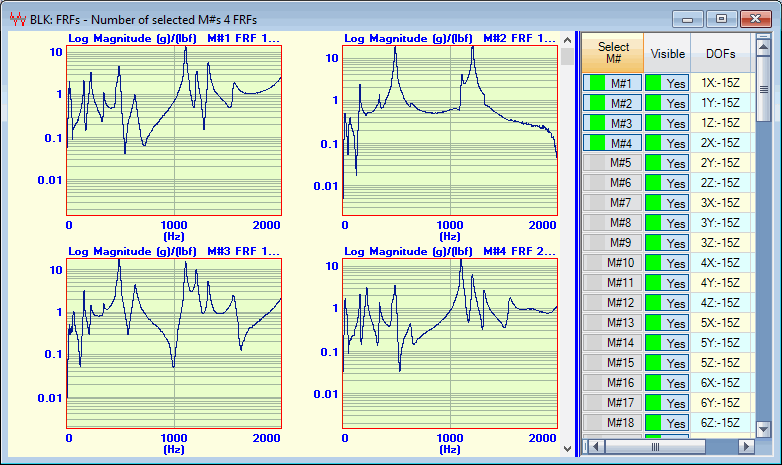
The commands in this menu are used to select and un-select M#s.
Most Data Block window commands operate on all (or selected) M#s.
A selected M# is displayed with a green background in the graphics area, and its Select button is depressed in the M#s spreadsheet.
Right click on the graphics area or M#s spreadsheet to execute these commands from the drop down menu.

Data Block Showing Four Selected M#s.
When this command executed, a dialog box will open containing a drop down list of options for selecting M#s.
Choose a method from the Select By drop down list
Choose items from the selection list below it
Hold down the Shift or Ctrl key to make multiple selections
Click on Select to select the M#s
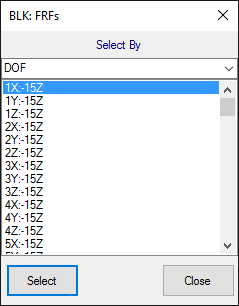
Select M#s By Dialog box.
Opens another dialog box wherein you can enter a Starting M# and a Skip M#s (number of M#s to skip over) for selecting M#s.
The default values are Starting M# = 1, and Skip M#s = 0.
Selects M#s by their Engineering Units.
Engineering Units are listed in the Units column in the M#s spreadsheet.
Selects M#s by their DOF;
DOF = Roving DOF : Reference DOF [Measurement Set]
Single channel M#s have only a Roving DOF.
Cross channel M#s have Roving & Reference DOFs.
Measurement Set numbers are used when data is acquired in multiple measurement sets.
DOFs are displayed in the DOFs column in the M#s spreadsheet
Selects M#s by their Roving DOF;
DOF = Roving DOF : Reference DOF
Selects M#s by their Reference DOF;
DOF = Roving DOF : Reference DOF
Selects M#s by their Roving DOF Point number;
DOF = Roving (Point Number & Direction) : Reference DOF.
Selects M#s by their Roving direction;
DOF = Roving (Point Number & Direction) : Reference DOF.
Selects M#s that form a rectangular matrix of rows & columns based on their DOFs.
Roving DOFs correspond to rows of the rectangular matrix.
Reference DOFs correspond to columns of the rectangular matrix.
Selects M#s by their Measurement Type.
Measurement Types are listed in the Measurement Type column in the M#s spreadsheet.
Selects M#s by their Measurement Set number;
DOF = Roving DOF : Reference DOF [Measurement Set]
Selects M#s by their Data Type.
Data Types are listed in the Data Type column in the M#s spreadsheet.
Selects M#s by their text Label.
Labels are listed in the Label column in the M#s spreadsheet.
Selects M#s by their Input Output property
Input Output is listed in the Input Output column in the M#s spreadsheet.
Selects M#s by their Source name.
Source names are listed in the Source Name column in the M#s spreadsheet.
Selects M#s by their Date/Time.
Date/Times are listed in the Date/Time column in the M#s spreadsheet.
Selects M#s by their Z-Axis text label.
The Z Axis labels are listed in the Z-Axis column in the M#s spreadsheet.
Selects all M#s.
Inverts the M# selection.
All selected M#s are un-selected, and all un-selected M#s are selected.
Un-selects all M#s.
The commands is this menu are used to sort (or re-order) the measurements in a Data Block.
Each measurement has a unique M#, which is its row in the M#s spreadsheet
M#s are important in a Data Block because the M# Links in a connected structure model use M#s to measurement data to animate.
When executed, a dialog box will open containing a list of options to sort by,
Choose a sorting option from the Sort By drop down list
Choose items from the Select From list, or check Select All to choose all items in the Select From list
Use Ascending, Descending, and the Remove button to obtain the desired Sort Using list
Click on Sort to sort the M#s

Sort M#s By Dialog box.
Sorts M#s by their Engineering Units.
Engineering Units are listed in the Units column in the M#s spreadsheet.
Sorts M#s by their DOF;
DOF = Roving DOF : Reference DOF [Measurement Set]
Single channel measurements have only a Roving DOF.
Cross channel measurements have Roving & Reference DOFs.
Measurement Set numbers are used when data is acquired in multiple measurement sets.
DOFs are displayed in the DOFs column in the M#s spreadsheet.
Sorts M#s by their Roving DOF;
DOF = Roving DOF : Reference DOF
Sorts M#s by their Reference DOF;
DOF = Roving DOF : Reference DOF
Sorts M#s by their Roving DOF Point number;
DOF = Roving (Point Number & Direction) : Reference DOF.
Sorts M#s by their Roving direction; of measurement
DOF = Roving (Point Number & Direction) : Reference DOF.
Sorts M#s that form a rectangular matrix of rows & columns based on their DOFs.
Roving DOFs correspond to rows of the rectangular matrix.
Reference DOFs correspond to columns of the rectangular matrix.
Sorts M#s by their Measurement Type.
Measurement Types are listed in the Measurement Type column in the M#s spreadsheet.
Sorts M#s by their Measurement Set number;
DOF = Roving DOF : Reference DOF [Measurement Set]
Sorts M#s by their Data Type.
Data Types are listed in the Data Type column in the M#s spreadsheet.
Sorts M#s by their text Label.
Labels are listed in the Label column in the M#s spreadsheet.
Sorts M#s by their Input Output property.
Input Output is listed in the Input Output column in the M#s spreadsheet.
Sorts M#s by their Source name.
Source names are listed in the Source Name column in the M#s spreadsheet.
Sorts M#s by their Date/Time.
Date/times are listed in the Date/Time column in the M#s spreadsheet.
Sorts M#s by their Z-Axis text label.
The Z Axis labels are listed in the Z-Axis column in the M#s spreadsheet.
Enables manual sorting of measurements by selecting them in a desired order. When this command is executed, a dialog box is opened with instructions for selecting M#s.
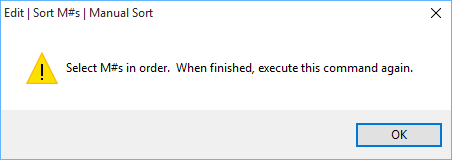
Dialog Prior to a Manual Sort of M#s.
Hold down the Ctrl key and click on each graph in the desired order
Or depress the Select M# buttons in the desired order, in the first column in the M#s spreadsheet
After all of the M#s have been selected,
Execute this command again to sort the measurements in the order in which they were selected
All un-selected M#s will follow the selected M#s in the new sorted order in the M#s spreadsheet
The selected M#s are moved upward in the M#s spreadsheet with each execution of this command. This command can be used to manually sort the order of the M#s so that the properties of measurements of interest are listed higher in the M#s spreadsheet.
The selected M#s are moved downward in the M#s spreadsheet with each execution of this command. This command can be used to manually sort the order of the M#s so that the properties of measurements of interest are listed lower in the M#s spreadsheet.
Displays real measurement data or the Real Part of complex data.
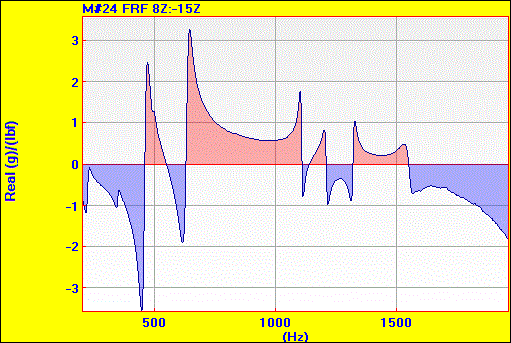
Data Block Window Showing Real Part of an FRF.
Displays the Imaginary Part of complex measurement data.
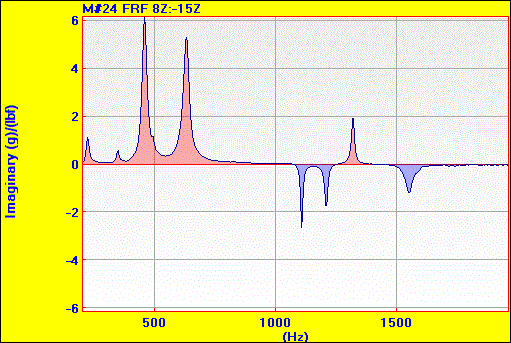
Data Block Window Showing Imaginary Part of an FRF.
Displays the magnitude of the measurement data.

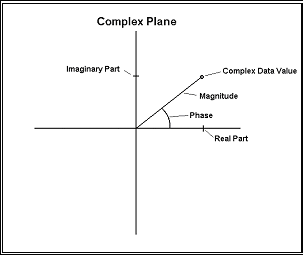
Real & Imaginary Parts on the Complex Plane.
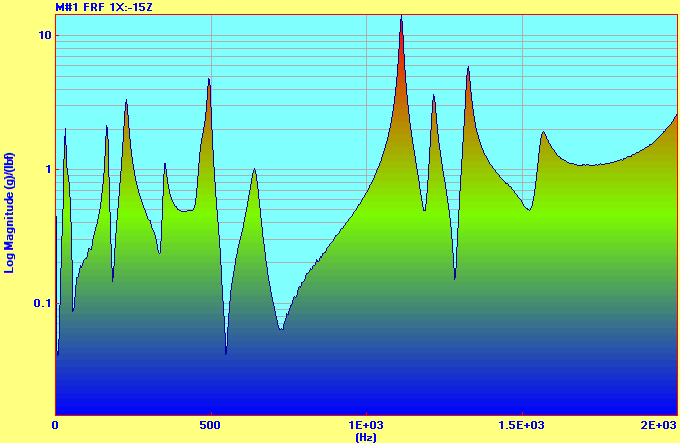
Data Block Window Showing Log Magnitude of an FRF.
Magnitudes can be displayed in Linear, Log or dB (decibels) format. When Log or dB is chosen, you can also choose the number of decades to display.
Linear, Log, dB & decades choices are made in the Format | Vertical Axis dialog box.
Right click in the graphics area, or double click on the vertical axis labels area to open the Format | Vertical Axis dialog box.
For Linear (RMS) quantities (FRFs, Fourier Spectra, etc.),
Magnitude (dB) = 20 Log 10( Magnitude )
For Power (MS) quantities (Auto Spectra, PSD’s, etc.),
Magnitude (dB) = 10 Log 10( Magnitude )
Displays the Phase of complex measurement data, with values between +180 & -180 degrees.
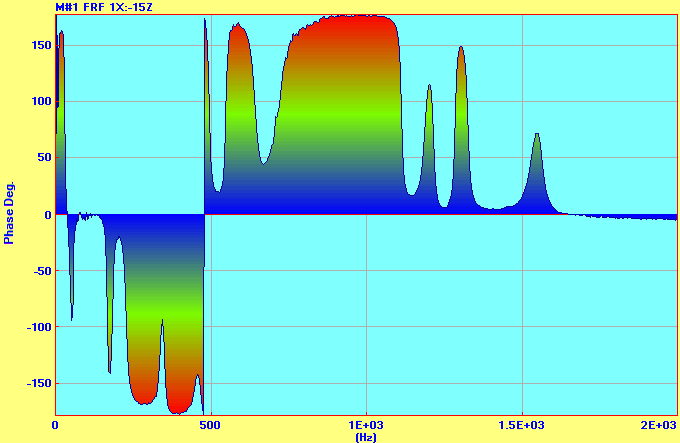
Data Block Window Showing Phase of an FRF.
Displays the measurements in CoQuad (Real & Imaginary) format.
The Real part is also called the Coincident waveform.
The Imaginary part is called the Quadrature waveform.
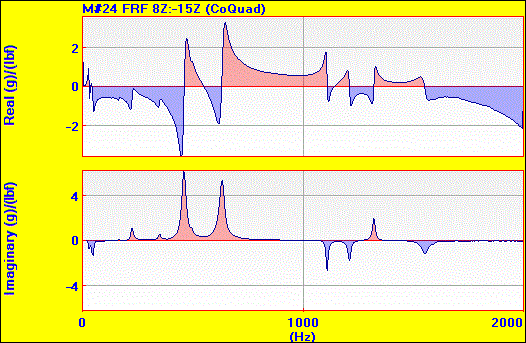
CoQuad Display.
Displays the measurements in Bode (Magnitude & Phase) format.
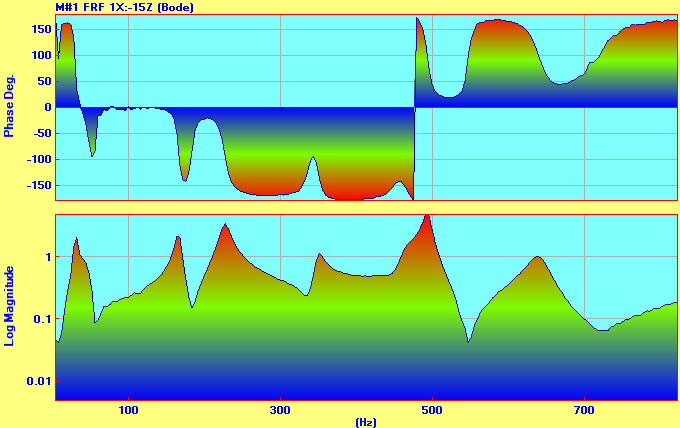
Bode Plot.
Displays the Real part on the horizontal axis and the Imaginary part on the vertical axis of each measurement.

Nyquist Plot of an FRF.